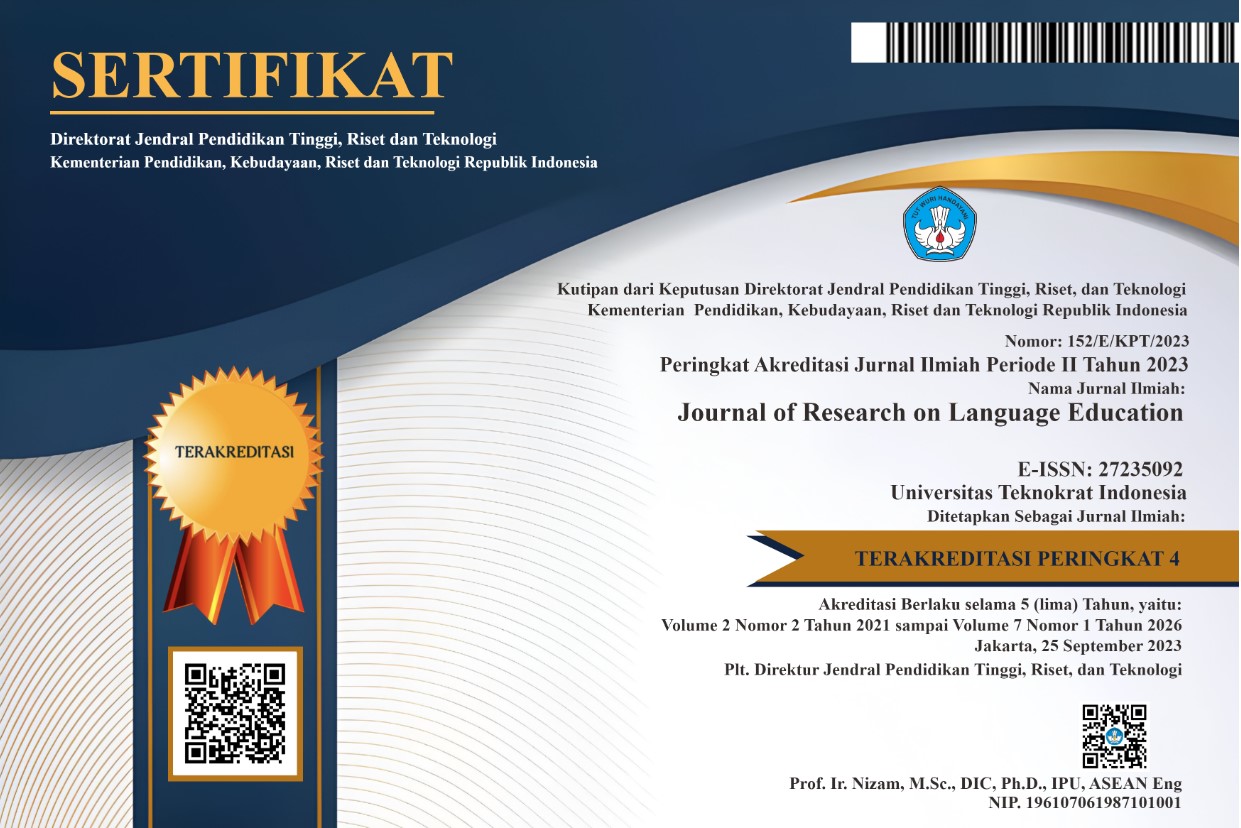NEGOTIATION OF MEANING: STUDENTS’ AWARENESS OF THEIR MISTAKES IN USING ENGLISH FOR THE SECONDARY SCHOOL LEVEL
Abstract
In traditional classes, teachers teach grammar in a deductive way with meaningless activities. The activities do not emphasize the uses of English in real life and lack of communication among teachers and students. Language awareness might give the students a challenge to pose questions and encourage them to explore themselves on how language works. The teachers might be able to encourage the students to participate to lead them to get communicative skills by using negotiation of meaning. This article is intended to explore and analyze the students’ mistakes when negotiating meaning in the language learning process. The qualitative descriptive research was employed in this study with 33 students in senior high school as the subjects of the research. The data were from the students’ interviews and recordings. The finding revealed that the students produced mistakes in grammar, pronunciation, and vocabulary. It showed that the extent of the students’ awareness in responding to a mistake in the negotiation of meaning was low. It was only 16 incorrect utterances that might be corrected by the students. It was divided into two sides, willingness and unwillingness to correct. Factors were affecting the students not to be aware during interaction such as focusing on meaning, the same proficiency level, and condition of the class.
Keywords
Full Text:
PDFReferences
Al-Khasawneh, F. M. (2012). Vocabulary Learning Strategies: A Case of Jordan University Of Science And Technology. English for Specific Purposes World, 34(12), 1-15.
Ayu, M. (2018). Interactive Activities for Effective Learning in Overcrowded Classrooms. Linguists: Journal of Linguistics and Language Teaching, 4(2), 1-6.
Baker, J., & Westrup, H. (2003). Essential Speaking Skills: A Handbook for English Language Teachers. London: Continuum.
Brown, H. D. (2000). Teaching by Principles: An Interactive Approach to Language Pedagogy (2nd Edition). New York: Pearson Education.
Guz, E. (2014). Gauging Advanced Learners’ Language Awareness: Some Remarks on the Perceptual Salience of Formulaic Sequences. Awareness in Action. Switzerland: Springer International Publishing.
Jones, L. (2007). The Student-Centered Approach. New York: Cambridge University Press.
Kawaguchi, S. & Ma, Y. (2012). Corrective Feedback, Negotiation of Meaning and Grammar Development: Learner-Learner and Learner-Native Speaker Interaction in ESL. Open Journal of Modern Linguistics, 2(2), 57-70.
Lestari, M. & Wahyudin, A. Y. (2020). Language Learning Strategies of Undergraduate EFL Students. Journal of English Language Teaching and Learning, 1(1), 25-30.
Lin, Y. (2011). A Language Awareness Approach to English Language Teaching in Joint Programs in China. Proceedings of the 16th Conference of Pan-Pacific Association of Applied Linguistics, 123-128.
Mandasari, B. & Oktaviani, L. (2018). English Language Learning Strategies: An Exploratory Study of Management and Engineering Students. Premise: Journal of English Education and Applied Linguistics, 7(2), 61-78.
Putri, E. & Sari, F. M. (2020). Indonesian EFL Students’ Perspectives towards Learning Management System Software. Journal of English Language Teaching and Learning, 1(1), 20-24.
Restrepo, A. I. (2006). Implementing a Language Awareness Approach to Grammar Through Topics. Medellin: Universidad de Antioquia.
Rido, A. & Sari, F. M. (2018). Characteristics of Classroom Interaction of English Language Teachers in Indonesia and Malaysia. International Journal of Language Education, 2(1), 40-50. DOI: http://dx.doi.org/10.26858/ijole.v2i1.5246
Riswanto & Haryanto, E. (2012). Improving Students’ Pronunciation through Communicative Drilling Technique at Senior High School (SMA) 07 South Bengkulu, Indonesia. International Journal of Humanities and Social Science 2(21).
Rohmatillah. (2014). A Study on Students’ Difficulties in Learning Vocabulary. Lampung: IAIN Press.
Samigan, A. (2016). First Language Interference in EFL Students’ Composition of IAIN Salatiga. Salatiga: Muhammadiyah Univerisity of Surakarta Press.
Sari, F. M. (2018). Patterns of Teaching-Learning Interaction in the EFL Classroom. Teknosastik: Jurnal Bahasa dan Sastra, 16(2), 41-48.
Tuan, N. H. & Mai, T. N. (2015). Factors Affecting Students’ Speaking Performance at LE Thanh Hien High School. Asian Journal of Educational Research, 3(2), 8-23.1
Wahyudin, A. Y. & Rido. A. (2020). Perceptuals learning styles preferences of international master's students in Malaysia. BAHTERA: Jurnal Pendidikan Bahasa Dan Sastra, 19(1), 95-103. https://doi.org/10.21009/bahtera.191.10.
DOI: https://doi.org/10.33365/jorle.v1i1.782
Refbacks
- There are currently no refbacks.

This work is licensed under a Creative Commons Attribution-NonCommercial-ShareAlike 4.0 International License.

Articles published in Journal of Research on Language Education is licensed
under a Creative Commons Attribution-ShareAlike 4.0 International License.
English Education Study Program, Faculty of Arts and Education.
Universitas Teknokrat Indonesia
Zainal Abidin Pagaralam 9-11 Bandar Lampung, Indonesia
All rights reserved.








